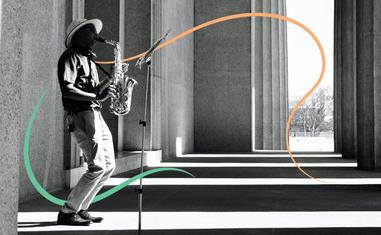The views expressed in our content reflect individual perspectives and do not represent the authoritative views of the Baha'i Faith.
How do we know when being “off track” is the track? What’s the difference between distraction and traction? And when does routine become a trap? Can new territory be home? Should I look for it?
Perhaps we can learn the answers to these profound questions from our artists.
The famed writer and philosopher Hermann Hesse took on some of these important questions in his novel Beneath the Wheel – when his hero, Hans Giebenrath, an “exceptionally bright boy, “something special,” toils to fulfill society’s expectations. Hesse described him:
Like a hamster, its cheeks distended by a store of provisions, Hans kept himself alive for a spell by drawing on his previously acquired knowledge. Then a painfully drawn-out death began, interrupted by brief ineffectual spurts whose utter futility made even Hans smile.
RELATED: Hazel Scott: A Famous Black Pianist, Singer, and Baha’i
In the book, all of Hans’ “conscientious guides of youth” – parents, teachers, and older adults – try to get him back on track through criticism, insult, disrespect, sarcasm, and condemnation. His father offers “a collection of every encouraging and morally outraged cliché at the good man’s disposal” as well as “a note of plaintive misery.”
Finally, Hans becomes so dispirited that he roams the countryside while “The doctors prescribed drops, cod liver oil, eggs and cold showers.” As you might expect, the story does not have a happy ending.
If only Hans hadn’t tried to stay on the track others had set for him. If only he had realized his distraction from study was a call to find traction within himself. If only he had seen his routine as a trap. With all of these things in the way, his own spirit had become lost to him. Poor Hans had looked everywhere for answers – except inside himself.
As the poet Langston Hughes said in Final Curve:
When you turn the corner
And you run into yourself
Then you know that you have turned
All the corners that are left
Baha’u’llah, the prophet and founder of the Baha’i Faith, said “True loss is for him whose days have been spent in utter ignorance of his self.”
The despairing lifeless drudgery of Hans stands in sharp contrast to creative artists and musicians whose constant search for their own inner cutting edge uncovers the definition of excellence in their chosen fields.
Herbie Hancock, the iconic jazz keyboardist and composer, said in a lecture on creativity: “When something unusual comes into my life, it is there for a reason and shouldn’t be ignored.”
He made this comment in the context of a story about trying to master an unusually difficult piece of music for a prestigious concert. Hancock thought of turning down the offer, fearing he would embarrass himself – but then came to this spiritual realization through meditation: “It’s only when we push ourselves beyond our limits that our work becomes meaningful to ourselves and respected by others.” The poet e.e. cummings put it this way:
seeker of truth
follow no path
all paths lead wheretruth is here
Cummings said:
The more you learn, the more you realize that there’s always something new to learn. And the more interesting life becomes. It’s an endless cycle of growth and exploration that starts the minute you’re born and never really ends. Sure, you can stop exploring outwardly, but there are always new things to explore inwardly. New layers of yourself to uncover.
For him, new territory is our only real home. We can never go back – we can only move forward.
Clyfford Still, an early abstract impressionist painter, described his work:
I never wanted color to be color. I never wanted texture to be texture, or images to become shapes. I wanted them all to fuse into a living spirit. These are not paintings in the usual sense, they are life and death merging in fearful union … they kindle a fire; through them I breathe again, hold a golden cord, find my own revelation.
Abdu’l-Baha, Baha’u’llah’s successor and the perfect exemplar of the Baha’i teachings, explained that being in a rut or taking the easy way out in life can never bring us happiness. As these creative artists all testify, our purpose in life involves finding, acquiring, and reflecting the perfections of Creator. Abdu’l-Baha explained this as a lifelong process which requires turning away from society’s expectations and influences, and instead allowing one’s own heart to turn inward toward the divine realities:
The wisdom of the appearance of the spirit in the body is this: The human spirit is a divine trust which must traverse every degree, for traversing and passing through the degrees of existence is the means of its acquiring perfections.
Of course, perfection is unattainable, but as all true artists know, the quest itself uncovers the good stuff of life:
Thus man is a perfect mirror facing the Sun of Truth and is the seat of its reflection. The splendor of all the divine perfections is manifest in the reality of man, and it is for this reason that he is the vicegerent and apostle of God. If man did not exist, the universe would be without result, for the purpose of existence is the revelation of the divine perfections.
Langston Hughes, one of the leaders of the Harlem Renaissance in the 1920s, and creator of what is known as “jazz poetry,” wrote in his poem “Harlem:”
What happens to a dream deferred?
Does it dry up
like a raisin in the sun?
Or fester like a sore —
And then run?
Does it stink like rotten meat?
Or crust and sugar over —
like a syrupy sweet?Maybe it just sags
like a heavy load.Or does it explode?
RELATED: How Jazz Promotes Oneness: An Interview with Mtali Shaka Banda
When the famous saxophonist, composer, and teacher Wayne Shorter was interviewed regarding his own half-century quest for innovation and creativity in music he was asked, “Where does the creative inspiration come from when you’re improvising together with other musicians?” He answered:
The inspiration is in always trying to do something that has not been done, to discover, to experience originality. It’s almost like, how do you play eternity? How do you write eternity in music? A lot of people don’t believe in it, they don’t want to talk about it. They say, “You only live once.” The word “eternity” doesn’t come into many conversations.
His interviewer asked, “But if eternity is in a moment?” Shorter answered, “It’s in the moment. Jazz!”
We are all here to make our own music, write our poems, paint our pictures, sing our songs. We are here to reflect the perfections of the spirit in this reality. We are not here to walk the hamster wheel like poor Hans, but to find our own ways of being our true selves.
Where is your own cutting edge? Only you know. Should you look for it? Yes! Then you are truly alive. Does it matter? Yes! It is the very purpose of existence.
Under The Rhythm of Jazz, by Ermira Mitre Kokomani
Under the rhythm of jazz,
I danced and sang my wintery cries,
buried in a lengthy silence,unbelted the ropes of cryptic fear,
the shadow that kept me hostage.Under the rhythm of jazz,
I unleashed my perplexed dilemmas,
gave away my nagging worries,unfettered the winter of my thoughts,
enlivened my dreary hopes.Under the rhythm of jazz,
my heart unfolded as a golden Lotus,
blooming over mud of thorns.Under the rhythm of jazz,
verses evinced my soulful truth,
lauded the unsung songs…

















Comments
Sign in or create an account
Continue with Facebookor